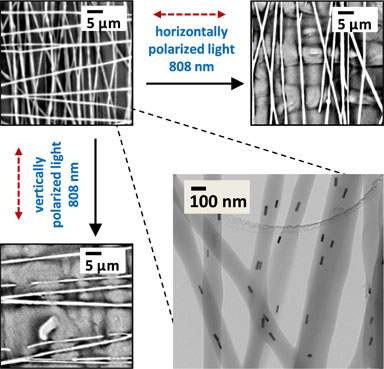Feb 22 2013
Researchers from North Carolina State University have developed a way to melt or “weld” specific portions of polymers by embedding aligned nanoparticles within the materials. Their technique, which melts fibers along a chosen direction within a material, may lead to stronger, more resilient nanofibers and materials.
 Polarized light selectively heats and melts nanofibers containing aligned gold nanorods within a cross-hatched mat when the polarization direction is parallel to the nanofiber direction.
Polarized light selectively heats and melts nanofibers containing aligned gold nanorods within a cross-hatched mat when the polarization direction is parallel to the nanofiber direction.
Physicists Jason Bochinski and Laura Clarke, with materials scientist Joe Tracy, placed specifically aligned gold nanorods within a solid material. Gold nanorods absorb light at different wavelengths, depending upon the size and orientation of the nanorod, and then they convert that absorbed light directly into heat. In this case, the nanorods were designed to respond to light wavelengths of 520 nanometers (nm) in a horizontal alignment and 800 nm when vertically aligned. Human beings can see light at 520 nm (it looks green), while 808 nm is in the near infrared spectrum, invisible to our eyes.
When the different wavelengths of light were applied to the material, they melted the fibers along the chosen directions, while leaving surrounding fibers largely intact.
“Being able to heat materials spatially in this way gives us the ability to manipulate very specific portions of these materials, because nanorods localize heat – that is, the heat they produce only affects the nanorod and its immediate surroundings,” Tracy says.
According to Bochinski, the work also has implications for optimizing materials that have already been manufactured: “We can use heat at the nanoscale to change mechanical characteristics of objects postproduction without affecting their physical properties, which means more efficiency and less waste.”
The researchers’ findings appear in Particle & Particle Systems Characterization. The work was funded by grants from the National Science Foundation and Sigma Xi. Graduate students Wei-Chen Wu and Somsubhra Maity and former undergraduate student Krystian Kozek contributed to the work.
Source: http://www.ncsu.edu/